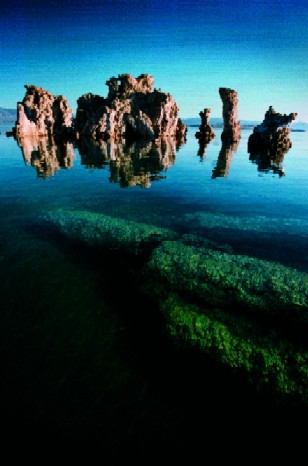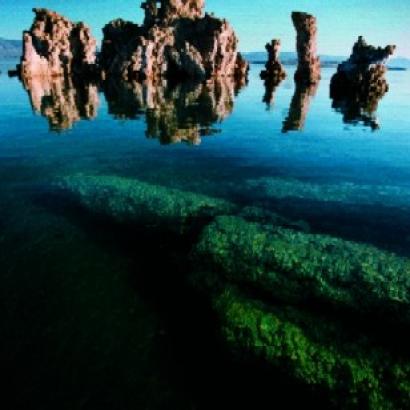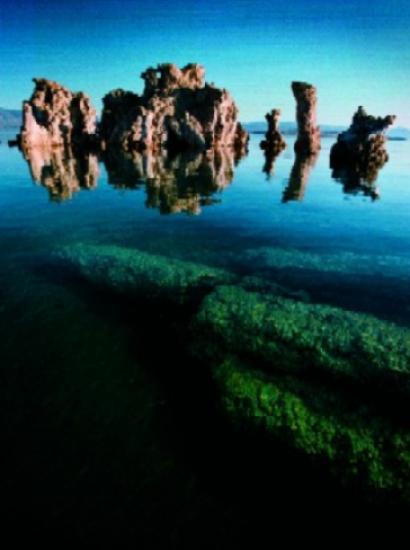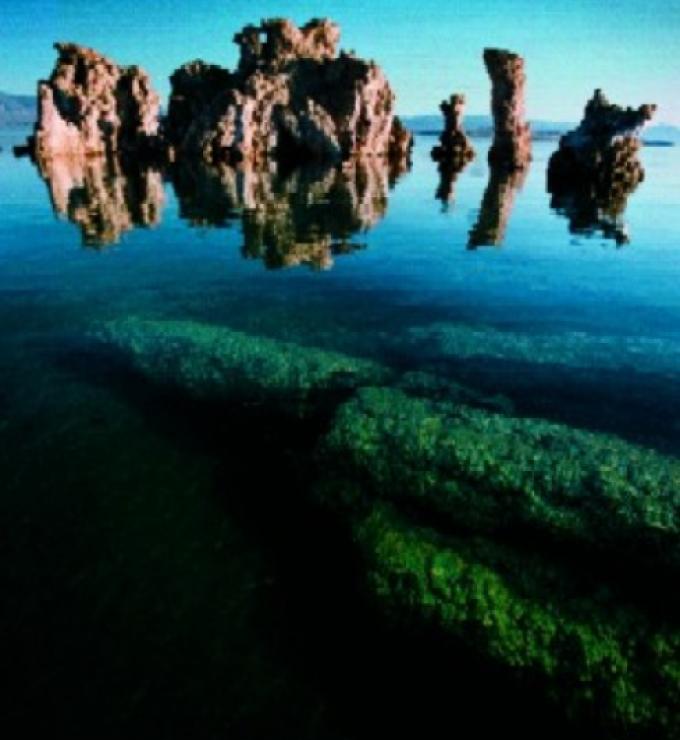The Owens Valley and Mono Basin in the eastern California Sierras are home to some of the purest water on the planet. Crystal Geyser, the big bottled water company is located there. Based on water rights acquired to the area in the early twentieth century, Los Angeles built one of the most elaborate water supply infrastructures found anywhere, with aqueducts, dams, conduits, reservoirs, and hydroelectric power stations. The city’s appropriative water rights—the kind that dominate in the West— allowed the water to be separated from the land and diverted to the Los Angeles Aqueduct.
The aqueduct historically supplied 80 percent or more of Los Angeles’s water. Recently, however, the city’s supply from the aqueduct has fallen. Forty percent now goes to environmental enhancement, about 166,000 acre feet of water annually, worth more than $83,000,000 a year. Some of this water goes to restore streams leading into Mono Lake to raise its level and reestablish trout fisheries. In lieu of this water, the city has had to turn to more-expensive and lower-quality sources.
| The problem with a litigious approach to allocating water is not only that it is hugely expensive but that it weakens property rights and the ability of markets to promote investment, trade, and the efficient use of water. |
These environmental water enhancements were not based on voluntary decisions by the city, however. Los Angeles lost its water following court rulings and administrative actions that weakened its property rights and reallocated its aqueduct flows. The city and its protagonists spent millions of dollars in years of litigation fighting over the water. Meanwhile, its capital investments in the aqueduct and power generators sit underutilized, with the citizens of Los Angeles bearing those costs.
The issue here is not the environmental and recreational values of additional water for Mono Lake. Rather, it is the process by which this water reallocation took place, what that means for future allocation decisions and the sensible use of water elsewhere. The environmental groups and government agencies that wanted more water for Mono Lake and its tributaries could have purchased it from Los Angeles (the city had held the water rights at least since the 1940s), but they did not. Los Angeles’s water rights were not respected; instead they were challenged in the courts under the public trust doctrine. Litigation was the vehicle for reassignment. The lake could have been filled much sooner at a lower total cost had a less antagonistic, market approach been employed. The environment would have benefited from market transactions, as would the citizens of Los Angeles.
THE COURTS AND THE PUBLIC TRUST DOCTRINE
The recent battle over Mono Lake was part of a larger effort to limit Los Angeles’s diversion of water from the Owens Valley and Mono Basin. In the 1970s, as the city shipped more water down the aqueduct, Mono Lake’s water level fell sharply. By 1981 it was 46 feet below where it had been in 1940. Fearing further loss, the National Audubon Society, Friends of the Earth, the Sierra Club, and the Mono Lake Committee sued the city in 1979 to halt the export of water, citing the public trust doctrine.
The public trust doctrine, an old common law principle, asserts the right of the state to intervene on behalf of the public for access to and use of certain lands and waters, such as tidewaters or navigable rivers. In the Mono Lake case, the plaintiffs successfully extended the doctrine to include smaller watercourses and wildlife habitat, arguing that, by drying up streams and lowering the lake’s level, Los Angeles was denying access to and use of those resources by the public. The case moved through the courts until it was finally heard by the California Supreme Court.
In National Audubon Society v. Superior Court (1983), the court held that Los Angeles’s water rights were to be limited by the state to protect public trust values: “It is an affirmation of the duty of the state to protect the peo-ple’s common heritage of streams, lakes, marshlands and tidelands.” The court called on the State Water Resources Control Board to regulate the city’s diversions.
Numerous court cases followed for more than a decade as the antagonists fought over the extent and nature of Los Angeles’s water rights. All the while, Mono Lake’s water level continued to drop, streams remained dry, and riparian and aquatic habitats remained unrestored. And the warring parties continued to waste resources in the conflict. By 1991 the Los Angeles Department of Water and Power estimated that it had spent up to $12 million for outside lawyers and consultants since 1979.
| The lake would have been filled much sooner at a lower total cost had a less antagonistic, market approach been employed. |
In the end, Los Angeles lost the water. In 1994 the state halted any further withdrawal of water from the Mono Basin for some 20 years, until the lake reached a targeted level. The value of the lost Mono water and hydroelectric power was estimated to be $35,460,000 annually; these costs were borne by Los Angeles. To make matters worse, the ruling invigorated advocacy groups to move aggressively to extend the public trust to other areas and uses.
The problem with this litigious approach to allocating water is not only that it is hugely expensive but that it weakens property rights and the ability of markets to promote investment, trade, and the efficient use of water. The public trust doctrine, which can be applied retrospectively to roll back preexisting water rights whenever they appear inconsistent with the public trust, is so vague and elastic that it can lead to extensive government regulation of water rights. It stresses that private rights are nonvested and revocable without compensation. A broad public trust mandate for state regulation also lowers the costs of holdup strategies by advocacy groups by providing them with the legal standing to contest private water diversions or proposed trades as violations of the doctrine. This can wreak havoc with water markets and lead to the public trust being reinterpreted by the courts whenever they decide that conditions have changed.
| In the 1970s, as Los Angeles shipped more water down the aqueduct, Mono Lake’s water level fell sharply. By 1981 it was 46 feet below where it had been in 1940. |
As a result, current claims to water cannot serve as a foundation for contracting future allocations. Indeed, the new water flows for Mono Lake that are considered part of the public trust today are not protected over the long run. They too could be reassessed by subsequent courts and directed to different uses. This subjective process, with discrete, abrupt changes, is unsettling to those who had grown accustomed to a particular water distribution and made investments based on it.
Another problem with the public trust is that it creates commons where none had existed before. By insisting on public access to water and other public trust resources, a potential exists for a “tragedy of the commons.” The state is supposed to regulate water use to prevent this from happening, but the experience with other resources is not encouraging. Regulatory agencies generally lack sufficient information on changing values to respond to them in a timely fashion. Their decisions are molded by political pressure from influential constituent groups (often incumbent users) or the bureaucracy itself. And because bureaucratic officials are not residual claimants to the costs or benefits of their decisions, they have little incentive to act in cost-effective ways. The result of all this has been waste, cumbersome responses, and, generally, the failure of government regulation to successfully address the problem of the commons.
In the face of all this, there is a pronounced trend toward property rights approaches to environmental and natural resource problems, that is, to consider public resources as “private” so as to instill incentives for wise stewardship and protection of the resource. For example, individual transferable quotas to improve fishing conditions and tradable emission permits for meeting air-quality targets are market solutions that have worked very well. Unfortunately, judicially expanding the public trust doctrine to water reallocation or public access to waterways for fishing and other recreational uses is moving in just the opposite direction. But water is too precious and vital a resource to ignore the lessons learned from other resources.
THE MARKET ALTERNATIVE
As pointed out earlier, demands for more water for Mono Lake could have been met by purchasing aqueduct water from Los Angeles. The advantages of this approach include everyone having gained a much more accurate assessment of the amount of water actually needed for restoring the environment—questions of science and economics. Although scientists, engineers, and economists were employed in the litigation, their studies were part of an adversarial process to take or hold onto water— which is not conducive to a reasoned examination of the water needed for various purposes.
| Markets generate more-accurate information about relative values than do arbitrary political, judicial, or administrative allocations. This was true in the former Soviet Union, and it is true in the western United States today. |
In contrast, a market encourages just such a reasoned and careful evaluation. Would-be purchasers must determine how much water they want to buy and how much they are willing to pay for it. Sellers must decide the value of their water. If the offer matches those values, some trade occurs. If it does not, then the buyer has to recalculate willingness to pay, decide not to purchase, or wait until a later time when conditions may have changed. Or the seller has to reassess how much the water is worth. In either case, experts on both sides are motivated to resolve how much water is truly required and to assess its value.
A great contribution of markets is that they generate more-accurate information about relative values than do arbitrary political, judicial, or administrative allocations. This was true in the former Soviet Union, and it is true for western water today.
Another advantage of a water market is that it recognizes existing property rights as a basis for exchange. There is a legal framework for bargaining among the parties to redistribute water. There is a recognized owner and a potential buyer who may agree or disagree at any point in time. The structure elicits negotiation and cooperation and provides for routine, timely redistribution as values change. A market thus reduces social conflict and division because in voluntary trades both parties benefit.
A final and related advantage of a market approach and secure property rights is that they encourage investment in water conservation, storage, allocation, and quality. Surely, given the semiarid nature of the West, it is in society’s interest to promote these investments. These ventures not only include those for urban supply infrastructure but also those for improvements in fish habitat and stream conditions. Such investments may take place privately, where controls on entry are possible, or publicly, when there are important amenity values at stake or when entry and use cannot be easily limited. Accordingly, buying water to restore stream fisheries and to raise Mono Lake’s water level could have involved a consortium of private parties and public agencies or organizations.
In the future more cases like Mono Lake will arise. The question is, how should we respond to them? Water markets are more efficient, less contentious, and timelier than judicial and administrative reallocation of water. Markets, however, require that property rights be defined and supported, not weakened by the extension of the public trust doctrine.
















